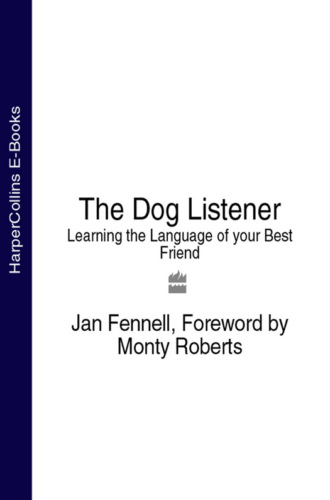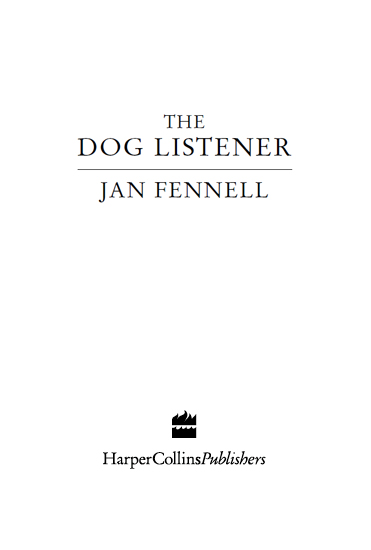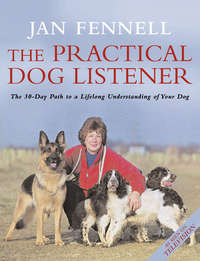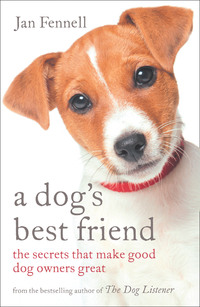
Полная версия
The Dog Listener: Learning the Language of your Best Friend


Copyright
HarperCollinsPublishers
1 London Bridge Street,
London SE1 9GF
www.harpercollins.co.uk
First published in Great Britain by HarperCollinsPublishers 2000
Copyright © Jan Fennell 2000 Foreword © Monty Roberts 2000
Grateful acknowledgment is made to The National Trust for Places of Historic Interest or National Beauty, for permission to quote from the poem ‘If’ by Rudyard Kipling.
Jan Fennell asserts the moral right to be identified as the author of this work
A catalogue record for this book is available from the British Library
All rights reserved under International and Pan-American Copyright Conventions. By payment of the required fees, you have been granted the nonexclusive, nontransferable right to access and read the text of this e-book on-screen. No part of this text may be reproduced, transmitted, downloaded, decompiled, reverse-engineered, or stored in or introduced into any information storage and retrieval system, in any form or by any means, whether electronic or mechanical, now known or hereinafter invented, without the express written permission of HarperCollins e-books.
HarperCollinsPublishers has made every reasonable effort to ensure that any picture content and written content in this ebook has been included or removed in accordance with the contractual and technological constraints in operation at the time of publication.
Source ISBN: 9780006532361
Ebook Edition © JULY 2014 ISBN: 9780007369546
Version: 2018-08-02
Dedication
For my son Tony
Contents
Cover
Title Page
Copyright
Dedication
Foreword by Monty Roberts
Introduction
1 The Lost Language
2 A Life with Dogs
3 Listening and Learning
4 Taking the Lead
5 The First Test
6 Amichien Bonding: Establishing Leadership of the Pack
7 Separate Lives: Dealing with Separation Anxiety
8 Mean and Moody: Dealing with Nervous Aggression
9 Peacemaking: Dogs that Bite
10 The Bodyguards: Overprotective Dogs
11 The Up-and-Down Game: Dogs that Jump Up
12 Non-Total Recall: Dogs that Run Wild off the Leash
13 Dog v. Dog: Taking the Heat out of Canine Confrontations
14 Tales of the Unexpected: Fear of Noises
15 New Dogs, Old Tricks: Introducing Puppies to the Home
16 Gremlins: Dealing with Problem Puppies
17 The House on Pooh Corner: Soiling in the Home
18 Situations Vacant: The Problems of Extended Packs
19 Biting the Hand that Feeds: Problem Eaters
20 Have Dog, Won’t Travel: Dealing with Car Chaos
21 Feet-Chewers and Tail-Chasers: Nervous Wrecks and How to Salvage Them
22 The Yo-Yo Effect: Overcoming the Problems of Rescue Dogs
23 Toys not Trophies: The Power of Play
24 ‘How’ve Ya Done That, Lady?’
Picture Section
Keep Reading
Acknowledgments
About the Author
About the Publisher
Caution
It is important to say here that my method cannot remove the aggressive tendencies of any dog. Certain breeds have been raised specifically for the purpose of fighting, and my methods will never be able to alter their potentially savage nature. What my method can do is allow people to manage their dogs so that this aggressive instinct is never called upon. Please exercise the greatest of caution when working with such dogs.
Foreword
by Monty Roberts
Dogs have played an important part in my life. My wife Pat and our family have had several over the years that were loving companions and important members of our family. It has been another wonderful creature that has dominated my career, however. I have spent my life developing – and often defending – the method I have discovered for communicating with the horse.
The appetite the dog world has for my ideas has been obvious throughout this time. Wherever I may be in the world, there are invariably four times as many dog owners and trainers as there are horse trainers at my demonstrations. Almost to a person, they have strong, positive comments to make about my method.
Given my time all over again, I would relish the challenge of adapting my ideas and taking them into the canine world. As it is though, I have more than enough to keep me occupied, developing and sharing my own discipline. Fortunately, in the last few years, I have become aware of a talented dog trainer who, inspired by my method, has undertaken the task already.
It was with a warm heart that I first learned of the work Jan Fennell has been doing in England. I have been lucky enough to meet her there and she has related much that reminds me of my own earlier experiences. Like me, Jan feels a deep sense of injustice at the way man has sometimes maltreated an animal he claims to call his friend. She also passionately believes that violence has no place in our relationship with animals. Her dream, too, is a world in which all species live in peace.
As with me, Jan has been slow to summon the courage to tell her story. I dragged my feet for years before I wrote my first book, The Man Who Listens to Horses. Jan has been just as careful in waiting to put her ideas into print. She now feels confident in her experience and is ready to share her remarkable work with a wider audience.
As she does so, I wish her and her ideas well. I am sure there will be those who will assail her. If my experience has taught me anything, it is that human nature has an almost limitless capacity for negativity. Each of us should be aware that for every grain of negative within the human community, there is a mountain of positive waiting for us among animals. We should also note that for every negative, however, there are literally hundreds thirsting for a better way to deal with man’s best friends.
I am proud to think that by sticking to my beliefs I have helped make the world a better place for the horse and, hopefully, for people too. I hope this book can achieve the same for another very special creature, the dog.
Monty Roberts, California, March 2000.
Introduction
I am a great believer in learning from the mistakes we make in life. I should be, I have made more than enough of my own, in my relations with humans as well as dogs. Of all the lessons the latter have taught me, none was as painful as that I received in the winter of 1972. It seems to me fitting that I should begin with the tragedy of Purdey. For reasons that will soon become apparent, her story is inseparable from my own.
At the time I was married and was raising my two young children, my daughter, Ellie, born that February, and Tony, then two-and-a-half. We were living as a family in London but had just decided to move to the countryside, and a small village in Lincolnshire, in the heart of England. Like so many people drawn to the rural life, we were all looking forward to going on long country walks and decided we would like a canine companion to take with us. Rather than buying a new puppy, we thought we’d rescue a dog. We liked the idea of giving a home to an animal that had had a raw deal, so off we trundled to the RSPCA and saw this rather sweet, six-month-old, black and white, cross Border collie-whippet. We took her home, where we decided to call her Purdey.
She was not the first dog in my life. That had been Shane, a magnificent, tricoloured Border collie I had been given by my father when I was a 13-year-old girl growing up in Fulham, west London. I had always loved dogs and, as a little girl, had invented an imaginary one called Lady. I remember my grandmother indulging me by talking to my fictional friend with me. I think I saw dogs then, as I do now, as objects of unquestioning love, total loyalty, qualities that are hard to find in humans. Shane’s arrival in our family had only confirmed my feelings.
I trained Shane with my father, according to the technique Dad had used himself in raising his dogs as a young boy. Dad was a gentle man, but he was also determined the dog was going to do what we said. If Shane did something wrong he got a tap on the nose or a smack on his bottom. But I got a smack on the bottom too and I thought it was OK, particularly as Shane was an extremely smart creature and seemed to understand what we wanted. I can still remember the pride I used to feel at taking him on to Putney Heath and Wimbledon Common on the Number 74 bus. Shane would sit by my side without a lead, behaving impeccably all the time. He was a super dog.
If something works you go along with it, you don’t mend what isn’t broken, as they say. So when we got Purdey I decided to apply the same method as I had with Shane, teaching her the difference between right and wrong with a mixture of love, affection and, where necessary, force.
At first this method seemed to work for Purdey too. She behaved well and fitted easily into the family in London. The problems started when we eventually moved to Lincolnshire that September. Our new home could not have presented a greater contrast to noisy, over-populated London. We lived in a small, isolated village. There were no street lights, the buses ran only twice a week and it was a four-mile hike to the nearest shop. I remember when I was a toddler I had been taken to the seaside for the first time. I took one look at the sea and ran away back up the hill away from it. My expression as a three-year-old was ‘too big enough’ and, if she could have spoken, I’m sure that’s what Purdey would have said about her new home. It seemed like everything was too big enough.
Soon after we arrived, Purdey began to behave in a way that I thought then was odd and not a little bit worrying. She would run off into the countryside, disappear for hours then come back obviously having had a great time somewhere. She was also hyperactive and seemed to be wound up by the slightest thing or sound. She followed me absolutely everywhere I went, which was a nuisance when I had the two small children. I wasn’t happy about her roaming the countryside like this. We all have a responsibility to make sure our dogs don’t cause danger or a nuisance to others. But I decided that I had taken this dog on and I was going to stick with her. I owed it to her to help her settle and that’s what I hoped to do. Events, however, soon overtook me.
The first inkling I got that something was wrong was when a local farmer came to see me. He told me in no uncertain terms that if I did not keep this dog under control he was going to shoot her. I was devastated, of course, but I also saw his point because he had livestock and Purdey was obviously running around and worrying the animals. So we put her in the huge, 200-feet garden we had, slipped a rope on her collar and attached it to the washing line so she could go no farther. But she still ran off whenever she could.
Matters took a turn for the worse one cold winter’s morning just before Christmas. I had come downstairs with the children and was going through our usual start-of-the-day routine. Purdey was frantically charging around as she always did first thing in the morning. I remember Ellie was crawling around on the floor, while Tony was playing the ‘little helper’, sorting out a pile of clothes I had in the sitting room. I went into the kitchen which led directly off the sitting room to collect their drinks when I heard a loud crash. I will never forget what I saw when I looked around. The dog had jumped up at Tony and jettisoned him through one of the panes of a sliding glass door. There was broken glass everywhere. From then on it was as if everything was happening in slow motion. I remember Tony looking at me with this stunned, sort of frozen expression as the blood poured from his little face. I remember rushing to Tony, scooping him up and grabbing a clean terry-towelling nappy from a pile of clothes. My days as a St John’s Ambulance volunteer had taught me to check for shards of broken glass. When I was happy that there were none, I began pressing the nappy on to his face, applying the pressure as hard as I could to stem the flow of blood. I then cradled him in my arms and headed for Ellie who was miraculously sitting still in the middle of this sea of broken glass. I scooped her up under my spare arm and sat there on my knees calling for help. All the while Purdey was running around like a lunatic, barking and jumping in the air as if she was playing some huge game.
It was every parent’s nightmare. When help eventually arrived, friends and family were unanimous. Tony’s injuries were awful and would leave him scarred for life. ‘This dog is a bad one, she’s a rogue,’ they said. I still felt responsible for Purdey, however, and was determined to give the dog another chance. She continued getting herself into problems every now and again, but, for a couple of months at least, all was relatively calm.
Then one sunny winter’s morning, just before Ellie’s first birthday in February, I was in another part of the house while Ellie was on the floor playing with her toys, supervised by my mother. The moment I heard my mother scream, I realised something had happened. When I got to the sitting room, my mother just shouted ‘The dog’s bitten her, Ellie did nothing and the dog’s bitten her. The dog’s turned.’ I didn’t want to believe it. But when I saw Ellie had a rather nasty little nick over her right eye I had no option. My head was spinning. Why had this happened? What had Ellie done? Where had my training gone wrong? I knew, however, that the time for questions was over.
As soon as he heard the news my father came round to see me. As a girl I had heard him talk of one of his favourite dogs, an Old English sheepdog cross called Gyp, and how he had ‘turned’. My grandmother had been trying to move him off a sofa and he had snapped at her. In my grandfather’s mind if a dog could turn on the hand that fed it then it was doomed, so Gyp was destroyed. My father did not have to spell it out for me. ‘You know what you’ve got to do, my girl, once they’ve gone, they’ve gone,’ he said sadly. ‘Don’t waste your time, just do it.’ That evening the children’s father came back from work. ‘Where’s the dog?’ he asked me. ‘She’s dead,’ I told him. I had taken her to the vet that afternoon and had her put down.
For a long time, part of me believed I had done the right thing with Purdey. Yet at the same time I always felt that I failed her, that it was my fault not hers. Even when I had her put down, I felt I was deserting her. It took me almost twenty years to confirm my suspicions. What I now know is that Purdey’s behaviour was all caused by my inability to understand that dog, to communicate with her, to show her what I actually wanted. In the most simple terms: she was a dog, a member of the canine not the human family, yet I was using a human language.
Over the past ten years I have learned to listen to and understand canine language. As that understanding has grown, I have been able to communicate with dogs, to help them – and their owners – overcome their problems. On many occasions my intervention has prevented a dog from being destroyed because of its seemingly untreatable behaviour. The joy I have felt each time I have saved a dog’s life in this way has been immense. I would be lying if I did not admit that it is also tinged with regret that I did not learn these principles in time to save Purdey.
The object of this book is to pass on the knowledge I have acquired. I will explain how I arrived at the method I now operate. I will then go on to outline how you can learn this language for yourself. Like all languages it has to be treated seriously. Learn it lazily or half-heartedly and it will only confuse both you and the dog with which you are trying to communicate. Learn it well and I can assure you that your animal will reward you with co-operation, loyalty and love.
Chapter 1
The Lost Language
‘The dog is a lion in his own house.’
Persian Proverb
Mankind has misplaced many secrets in the course of its history. The true nature of our relationship with the dog is among them. Like many millions of people around the world, I have always felt a special affinity exists between our two species. It goes beyond mere admiration for the dog’s athleticism, intelligence and looks. There is an intangible bond there, something special that connects us and probably has done since our earliest beginnings.
For most of my life, this feeling was founded on little more than instinct, an act of faith, if you like. Today however, the subject of man’s relationship with the dog is the subject of a burgeoning body of intriguing scientific evidence. That evidence indicates that the dog is not only man’s best friend but also his oldest.
According to the most up-to-date research I have read, the two species’ stories became intertwined as long ago as 100,000 years BC. It was then that the modern human, Homo sapiens, emerged from his Neanderthal ancestor in Africa and the Middle East. It was also around this time that the dog, Canis familiaris, began to evolve from its ancestor, the wolf, Canis lupus. There seems little doubt that the two events were connected and that the link lies in man’s earliest attempts at domestication. Of course our ancestors have incorporated other animals into their communities, most notably the cow, the sheep, the pig and the goat. The dog, however, was not just the first but by far the most successful addition to our extended family.
There is compelling evidence to suggest our forefathers valued their dogs above almost everything else in their life. One of the most moving things I have seen in recent years was a documentary on the discoveries made at the ancient Natufian site of Ein Mallah in northern Israel. There, in this parched and lifeless landscape, the 12,000-year-old bones of a young dog were found resting beneath the left hand of a human skeleton of the same age. The two had been buried together. The clear impression is that the man had wanted his dog to share his last resting place with him. Similar discoveries, dating back to 8500 BC, have been made in America, at the Koster site in Illinois.
The sense that man and dog had a unique closeness is only underlined by the work done by sociologists in communities in Peru and Paraguay. There, even today, when a puppy becomes orphaned it is common for a woman to take over the rearing process. The dog feeds off the woman until it is ready to stand on its own feet. No one can be sure how far back this tradition goes. We can only begin to guess at the intensity of the relationship these people’s ancestors must have had with their dogs.
There are, I’m sure, many more discoveries to be made, many more eye-opening insights to be gained. Yet even with the knowledge we now have, we should not be surprised that the empathy between the two species was so powerful. Quite the opposite in fact, the immense similarities between the two animals made them natural partners.
The wealth of study that has been done in this area tells us that both the ancient wolf and the Stone-Age man shared the same driving instincts and the same social organization. In simple terms, both were predators and lived in groups or packs with a clear structure. One of the strongest similarities the two shared was their inherent selfishness. A dog’s response to any situation – like man’s – is ‘what’s in it for me?’ In this instance, it is easy to see that the relationship they developed was of immense mutual benefit to both species.
As the less suspicious, more trusting wolf settled into its new environment alongside man, it found it had access to more sophisticated hunting techniques and tools such as snares and stone arrows, for instance. At night it could find warmth at the side of man’s fire and food in the form of discarded scraps. It was little wonder it took so easily to the domestication that was about to begin. By introducing the wolf to his domestic life, man reaped the benefits of a superior set of instincts. Earlier in his history, the Neanderthal man’s exaggerated proboscis had provided him with a powerful sense of smell; his descendant saw that by integrating the newly domesticated wolf into the hunt, he could once more tap into this lost sense. The dog became a vital cog in the hunting machine, helping to flush out, isolate and, if necessary, kill the prey. In addition to all this, of course, man enjoyed the companionship and protection the dog provided within the camp.
The two species understood each other instinctively and completely. In their separate packs, both man and wolf knew their survival depended on the survival of their community. Everyone within that community had a role to perform and got on with it. It was only natural that the same rules should be applied in the extended pack. So while humans concentrated on jobs like fuel gathering, berry picking, house repairs and cooking, the dogs’ main role was to go out with the hunters as their eyes and ears. They would perform a similar role back within the camp, acting as the first line of defence, warding off attackers and warning the humans of their approach. The degree of understanding between man and dog was at its peak. In the centuries that have passed since then, however, the bond has been broken.
It is not hard to see how the two species have gone their separate ways. In the centuries since man has become the dominant force on earth, he has moulded the dog – and many other animals – according to the rules of his society alone. It did not take man long to spot he could adjust, improve and specialise the skills of dogs by putting them together selectively for breeding purposes. As early as 7000 BC, in the Fertile Crescent of Mesopotamia, for instance, someone noticed the impressive hunting skills of the Arabian desert wolf, a lighter, faster variety of its northern relative. Slowly the wolf evolved into a dog able to chase and catch prey in this harsh climate and, more importantly, to do so according to man’s commands. The dog – variously known as the Saluki, Persian greyhound or gazelle hound – remains unchanged today and may well be the first example of a purebred dog. It was certainly not the last. In ancient Egypt, the Pharaoh hound was bred for hunting. In Russia, the borzoi was bred to chase bears. In Polynesia and Central America, communities even developed dog breeds specifically for food.
The process has continued through the ages, aided by the dog’s willingness to be ‘imprinted’ by our species. Here in England, for instance, the hunting culture of the landowning aristocracy produced a collection of dogs customised to fulfil specific roles. On a 19th-century estate, a typical pack would include a springer spaniel, to literally spring or flush the game from cover, a pointer or setter to locate birds, and a retriever to return the dead or wounded game to the handler.
Elsewhere, other breeds maintained the historic bond between man and dog even more closely. Nowhere was this exemplified better than in the development of guide dogs for the blind. It was at the end of the Great War, at a large country convalescent home in Potsdam, Germany, that a doctor working with injured veterans noticed just by chance that when patients who had lost their sight started moving towards a flight of steps his German shepherd would cut them off. The doctor sensed the dog was turning them away from danger. He began training his dogs specifically to use this natural shepherding ability to help humans who could no longer see. The guide dog for the blind developed from there. It may be our most direct throwback to that earliest community. Here was a dog providing a sense that man has lost. Unfortunately it is a rare example of co-operation in the modern world.









